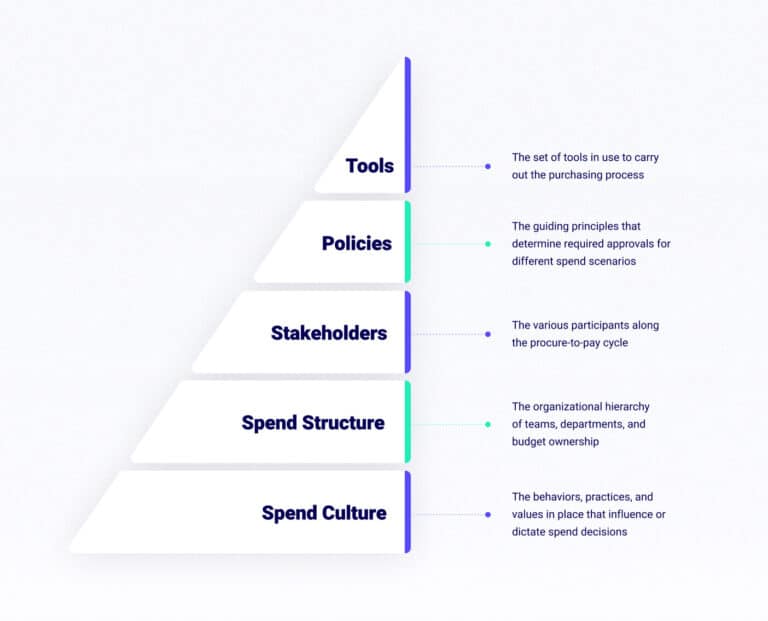As organizations grow and evolve, their purchasing processes need to undergo certain upgrades in order to keep up. More purchase requests, more complexity, and more spending create a disorganized environment that needs updating. The best place to start is with your approval workflow, and making it operational starts with designing an official approval matrix. Beyond deploying solutions that help your team automate processes and leave behind manual tasks, designing and implementing an official approval matrix will help you streamline and accelerate approval flows for less complicated purchasing processes.
What is an Approval Matrix?
A company’s purchase approval matrix is a table that outlines who’s required to sign off on a business purchase according to company policies, and provides the business rules for routing the approval tasks for those purchases. The various stages of your team’s approval processes, including which approvers or stakeholders are required to sign off on specific behaviors within those stages, make up the approval matrix. Not every company has one in place, but they are very beneficial to complex processes, especially as organizations quickly grow. Your purchase approval matrix will be defined according to company policies already in place, as well as to the company culture, structure, and stakeholders. Designing an approval matrix will provide your team with an official approval policy and therefore, a structured roadmap to control costs and eliminate mess.
How to Get Started
Your company policies are a crucial part of the spend pyramid which dictates the characteristics and approach of your approval process overall.

Before you can begin outlining your approval matrix in a visual representation, think about your company spend culture as a whole, and consider the various levels of the spend pyramid that will affect foundational influence on your finished matrix.
Your company’s culture will influence its structure, which dictates who the stakeholders are (as well as how many). Both company structure and stakeholders will determine your other policies. These can be based on:
- Budget items
- Monetary thresholds
- Special types of purchases
- Vendors and subsidiaries
Each will differ per organization and rate of growth, and each should be reviewed and solidified before moving forward with the matrix design.
Defining Your Policies
- Assign approvers according to monetary thresholds
Approval authority is perhaps the most important thing to consider when designing a matrix as part of your business process. It’s common that regular approvers will be bypassed in favor of an approver higher in status if the purchase request is quite large or specific.
For example, purchase requests between $15,000 and $25,000 are to require the approval of the VP of Finance, bypassing a single manager or many team managers and supervisors before moving on to the next step in the approval process. Decide what monetary thresholds you’ll typically be working with, and which approvers are required to sign off on each.
- Assign approvers according to specific budget items
Purchase requests from different departments and of different amounts require different approvers. Outline each set of approvers per department and which budget items they are responsible for.
- Outline the situations and purchases that will require a unique approver
Sometimes specific purchase requests will require a different approver than usual. What special circumstances in your company will require a unique approver? Be sure to list the details of these circumstances, including purchase amount, budget item, etc.
- Assign special approvers to subsidiaries
Decide on the approving authority, or who will be required to approve purchases requests for specific subsidiaries. Each subsidiary in an organization will likely have slightly different processes, maybe even different languages, depending on the location and size. These special approvers may also be in charge of approving new vendors in those subsidiaries.
Defining Your Stakeholders
- Define all stakeholders and outline each department they are from
Getting a true understanding of exactly who is involved and what team or department they’re a part of will help provide a clear picture of both your key players and more minor stakeholders of any approval process.
- Define each tier of approvers
Creating an approval matrix requires organizations to clearly define and outline the hierarchy of approvers. The VP of Finance or CFO is typically at the top, followed by department supervisors or direct team managers. This hierarchy is dependent on company structure, and every company is different.
Ensuring it All Fits Within Your Organizational Structure
- Review the hierarchy
You’re almost there, but before you can put all of this into design you need to make sure that the policies you’ve laid out are supported by your organizational structure. Meaning, your company’s structural hierarchy of teams, departments, and budget ownership is accurately reflected in the way you’ve outlined various stakeholders and policies.
- Who gives this matrix the final seal of approval?
After all collaborators have contributed and the matrix is neatly outlined, who is responsible for signing off? Whether the decision making authority is the VP of finance or the CFO, the approval matrix must be officially accepted and implemented before using.
New supervisors or department shifts can cause your organization to require amendments or updates to the approval matrix. Stay aware of any changes in hierarchy and make sure all stakeholders are kept informed once those updates are implemented.
Deploying Your New Approval Matrix
With a newly implemented approval matrix, your company spending will benefit from an organized set of financial and internal controls. More requesters and more spenders doesn’t have to equal a chaotic approval mess; with a matrix in place you’ll have more visibility (no more end-of-month surprises) and control over each operation.
If your team is relying on manual processes like emails and spreadsheets to manage approvals, the matrix is a welcomed guide that will contribute to more organization and collaboration. However, your new matrix can be amplified with automated tools like cloud-based PO management platforms or vendor management systems that will greatly accelerate your purchasing processes and help you get the most out of your new policy.
Understanding that you need to have an approval policy in place probably means you have the need for a software solution that can help you streamline communication and eliminate bottlenecks. The time and effort spent designing and organizing your matrix will go to waste if you don’t have the right tools implemented.

